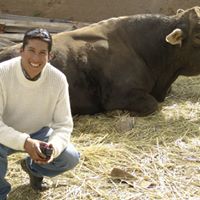David S Alavi
age ~63
from Eugene, OR
- Also known as:
-
- David Sadri Alavi
- David Ala Vi
- Davis Alavi
- Phone and address:
-
2221 Brittany St, Eugene, OR 97405
5419142884
David Alavi Phones & Addresses
- 2221 Brittany St, Eugene, OR 97405 • 5419142884
- Ashland, OR
- Wexford, PA
Us Patents
-
Spectrally-Encoded Labeling And Reading
view source -
US Patent:7063260, Jun 20, 2006
-
Filed:Nov 4, 2003
-
Appl. No.:10/704019
-
Inventors:Thomas W. Mossberg - Eugene OR, US
Christoph M. Greiner - Eugene OR, US
Dmitri Iazikov - Springfield OR, US
David S. Alavi - Eugene OR, US -
Assignee:LightSmyth Technologies Inc - Eugene OR
-
International Classification:G06K 7/10
-
US Classification:235454, 235375, 23546206
-
Abstract:A spectrally-encoded label comprises a spectrally-selective optical element having a label spectral signature. The label spectral signature is determined according to a spectral-encoding scheme so as to represent predetermined label information within the spectral encoding scheme. The label emits output light in response to input light selected by the label spectral signature of the optical element. A spectrally-encoded label system further comprises an optical detector sensitive to the output light emitted from the label, and a decoder operatively coupled to the detector for extracting the label information according to the spectral encoding scheme, and may also include a light source providing the input light for illuminating the label.
-
Spectrally-Encoded Labeling And Reading
view source -
US Patent:7341189, Mar 11, 2008
-
Filed:Jun 20, 2006
-
Appl. No.:11/425369
-
Inventors:Thomas W. Mossberg - Eugene OR, US
Christoph M. Greiner - Eugene OR, US
Dmitri Iazikov - Springfield OR, US
David S. Alavi - Eugene OR, US -
Assignee:LightSmyth Technologies Inc - Eugene OR
-
International Classification:G06K 7/10
-
US Classification:235454, 23546235
-
Abstract:A spectrally-encoded label comprises a spectrally-selective optical element having a label spectral signature. The label spectral signature is determined according to a spectral-encoding scheme so as to represent predetermined label information within the spectral encoding scheme. The label emits output light in response to input light selected by the label spectral signature of the optical element. A spectrally-encoded label system further comprises an optical detector sensitive to the output light emitted from the label, and a decoder operatively coupled to the detector for extracting the label information according to the spectral encoding scheme, and may also include a light source providing the input light for illuminating the label.
-
Polarization-Engineered Transverse-Optical-Coupling Apparatus And Methods
view source -
US Patent:20030081903, May 1, 2003
-
Filed:Oct 30, 2002
-
Appl. No.:10/284041
-
Inventors:Kerry Vahala - San Gabriel CA, US
Peter Sercel - Pasadena CA, US
Oskar Painter - Pasadena CA, US
David Vernooy - Sierra Madre CA, US
David Alavi - Eugene OR, US -
International Classification:G02B006/26
G02B006/27 -
US Classification:385/050000, 385/043000, 385/028000, 385/011000
-
Abstract:An optical signal may be received into orthogonal linearly polarized modes of a transmission optical waveguide, the transmission waveguide including first and second transverse-coupling segments thereof. Optical signal polarized along one polarization direction may be substantially completely transferred from the transmission waveguide into a first transverse-coupled waveguide, the first transverse-coupled waveguide being optically transverse-coupled to the first transverse-coupling segment of the transmission waveguide. Optical signal polarized along the other polarization direction may be substantially completely transferred from the transmission waveguide into a second transverse-coupled waveguide, the second transverse-coupled waveguide being optically transverse-coupled to the second transverse-coupling segment of the transmission waveguide. The optical signals carried by the first and second transverse-coupled waveguides may be combined into a single waveguide. The polarization directions of the transmission waveguide may be rotated about 90 between the first and second transverse-coupling segments.
-
Systems And Methods For High-Speed Searching And Filtering Of Large Datasets
view source -
US Patent:20120179699, Jul 12, 2012
-
Filed:Jan 10, 2012
-
Appl. No.:13/347646
-
Inventors:Roy W. Ward - Eugene OR, US
David S. Alavi - Eugene OR, US -
International Classification:G06F 17/30
G06F 7/00 -
US Classification:707754, 707797, 707E17039, 707E17044, 707E17018
-
Abstract:A data structure comprises a clump header table and an inline tree data structure. The inline tree, representing filterable data fields of hierarchically organized data records, comprises an alternating sequence of first-level binary string segments, each followed by one or more corresponding second-level binary string segments. Each clump header record includes an indicator of a location in the inline tree of corresponding binary string segments. A dedicated, specifically adapted conversion program generates the clump header file and the inline tree for storage on any computer-readable medium, and the inline tree can be read entirely into RAM to be searched or filtered. A dedicated, specifically adapted search and filter program is employed to list or enumerate retrieved data records. Run-time computer code generation can reduce time required for searching and filtering. One example includes spatial searching and filtering of data records that include spatial coordinates as data fields.
-
Ring Optical Resonator For Generation And Detection Of Millimeter-Wave Or Sub-Millimeter-Wave Electromagnetic Radiation
view source -
US Patent:20220271489, Aug 25, 2022
-
Filed:Feb 22, 2022
-
Appl. No.:17/677888
-
Inventors:- Lorton VA, US
David S. Alavi - Eugene OR, US -
Assignee:Microtech Instruments, Inc. - Lorton VA
-
International Classification:H01S 3/083
H01S 3/063 -
Abstract:A ring optical resonator and one or more input optical waveguides are arranged on a substrate, and are arranged and positioned to establish evanescent optical coupling between them. The ring optical resonator, the substrate, or both include one or more nonlinear optical materials. To detect an electromagnetic signal at frequency νincident on the resonator, an input optical signal at frequency νpropagates along the waveguide and around the resonator. The incident electromagnetic signal and the input optical signal generate one or more sideband optical signals at corresponding optical sideband frequencies ν=ν+νor ν=ν−ν. To generate an electromagnetic signal to propagate away from the resonator, input optical signals at frequencies νand νpropagate along one or more waveguides and around the resonator and generate the electromagnetic signal incident at frequency ν=|ν−ν|.
-
Systems And Methods For Storing, Updating, Searching, And Filtering Time-Series Datasets
view source -
US Patent:20190294599, Sep 26, 2019
-
Filed:Mar 29, 2019
-
Appl. No.:16/370802
-
Inventors:- Eugene OR, US
David S. Alavi - Eugene OR, US -
International Classification:G06F 16/22
G06F 16/2458 -
Abstract:A method includes generating from a time-series dataset multiple corresponding time-slice datasets. Each time-slice dataset has a corresponding time-slice time index and includes field-value data strings and associated field-value-time-index data strings, or pointers indicating the corresponding strings in an earlier time-slice dataset, that are the latest in the time-series dataset that are also earlier than the corresponding time-slice time index. A query of the time-series dataset for latest data records earlier than a given query time index is performed by using the time-slice datasets to reduce or eliminate the need to directly access or interrogate the time-series dataset.
-
Systems And Methods For Storing, Updating, Searching, And Filtering Time-Series Datasets
view source -
US Patent:20170228405, Aug 10, 2017
-
Filed:Feb 9, 2016
-
Appl. No.:15/019965
-
Inventors:- Eugene OR, US
David S. Alavi - Eugene OR, US -
International Classification:G06F 17/30
-
Abstract:A method includes generating from a time-series dataset multiple corresponding time-slice datasets. Each time-slice dataset has a corresponding time-slice time index and includes field-value data strings and associated field-value-time-index data strings, or pointers indicating the corresponding strings in an earlier time-slice dataset, that are the latest in the time-series dataset that are also earlier than the corresponding time-slice time index. A query of the time-series dataset for latest data records earlier than a given query time index is performed by using the time-slice datasets to reduce or eliminate the need to directly access or interrogate the time-series dataset.
-
Systems And Methods For High-Speed Searching And Filtering Of Large Datasets
view source -
US Patent:20150205814, Jul 23, 2015
-
Filed:Jan 27, 2015
-
Appl. No.:14/607038
-
Inventors:- Eugene OR, US
David S. Alavi - Eugene OR, US -
International Classification:G06F 17/30
-
Abstract:A data structure comprises a clump header table and an inline tree data structure. The inline tree, representing filterable data fields of hierarchically organized data records, comprises an alternating sequence of first-level binary string segments, each followed by one or more corresponding second-level binary string segments. Each clump header record includes an indicator of a location in the inline tree of corresponding binary string segments. A dedicated, specifically adapted conversion program generates the clump header file and the inline tree for storage on any computer-readable medium, and the inline tree can be read entirely into RAM to be searched or filtered. A dedicated, specifically adapted search and filter program is employed to list or enumerate retrieved data records. Run-time computer code generation can reduce time required for searching and filtering. One example includes spatial searching and filtering of data records that include spatial coordinates as data fields.
Resumes

Registered Patent Agent
view sourcePosition:
Registered Patent Agent at David S Alavi Inc
Location:
Eugene, Oregon Area
Industry:
Legal Services
Work:
David S Alavi Inc since Jan 1996
Registered Patent Agent
University of Oregon Mar 1993 - Jul 2002
Director, Shared Laser Facility
Registered Patent Agent
University of Oregon Mar 1993 - Jul 2002
Director, Shared Laser Facility
Education:
University of Pittsburgh 1986 - 1990
PhD, Chemistry The Ohio State University College of Medicine 1984 - 1985
The Ohio State University 1980 - 1984
BS, mathematics and biochemistry
PhD, Chemistry The Ohio State University College of Medicine 1984 - 1985
The Ohio State University 1980 - 1984
BS, mathematics and biochemistry
Skills:
Patents
Patent Prosecution
Patent Drafting
Research
Writing
Editing
Teaching
Chemistry
Physics
Patentability
Optics
Photonics
Optoelectronics
Laser Physics
Nonlinear Optics
Patent Prosecution
Patent Drafting
Research
Writing
Editing
Teaching
Chemistry
Physics
Patentability
Optics
Photonics
Optoelectronics
Laser Physics
Nonlinear Optics
Interests:
ultrarunning

David Alavi
view sourceName / Title
Company / Classification
Phones & Addresses
Owner
David S Alavi Inc
Attorneys
Attorneys
2852 Willamette St Pmb 402, Eugene, OR 97405
5416869462
5416869462
President
David S. Alavi, Inc
Business Services
Business Services
3762 W 11 Ave, Eugene, OR 97402
Youtube
Classmates

David Alavi Steubenville...
view sourceDavid Alavi 1980 graduate of Steubenville High School in Steubenville, OH is on Classmates.com. See pictures, plan your class reunion and get caught up with David and other high ...

Steubenville High School,...
view sourceGraduates:
Bobby Goettge (1973-1978),
Sharon Mechling (1968-1972),
Dana Isler (1986-1990),
David Alavi (1976-1980),
Gloria Schiappa (1963-1967)
Sharon Mechling (1968-1972),
Dana Isler (1986-1990),
David Alavi (1976-1980),
Gloria Schiappa (1963-1967)

David Alavi Riveros
view sourceFriends:
Nataly Maceda Heredia, Carlos Alberto Quispe Llave, Juan Carlos Apaza Sirpa

David Alavi Rafiepour
view sourceFriends:
Ebrahim Derakhshani, Mohammad Saeed Aghareb Parast, Iman Vafaei, Mehdi Moosavian

Jeremiah David Alavi
view sourceFriends:
Priscilla R. Williams, Andrea Michele McKinney, Hannah Nichole Lce
Flickr
Get Report for David S Alavi from Eugene, OR, age ~63













